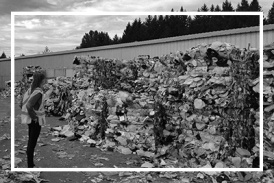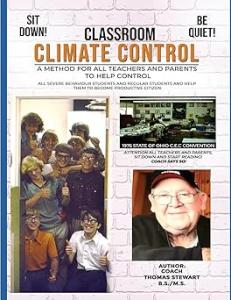Teaching with Grit and Grace: Coach Stewart’s Real-Life Guide to Reaching Challenging Students
Veteran educator Coach Stewart shares transformative teaching methods and classroom strategies drawn from 38 years of real-life experience.
Coach Stewart began his teaching career at Serena, Illinois, in 1965. Coach taught Biology and was the Head Track Coach and also taught Basketball. The following year, in 1966, Coach moved to Col. Crawford High School in Ohio, where he was the Aquatics Instructor for grades seven through 12 and the Head Swimming and Diving Coach. In 1967, Coach moved to Crestline school system where he was the eighth-grade Earth Science Teacher, Head Track Coach, and Head Cross Country Coach. He transferred into teaching Special Education after a religious experience happened at a Junior High Dance that he was chaperoning. Some people call his experience an epiphany, and it is explained in the book as a true story. He had given over thirty years of dedication to his method of helping students learn their classes and sending a few of them who qualified to regular classes, which they called “Mainstreaming.”
Starting in 1970, Coach Stewart started to individualize each student into his own program, which later the government caught on to the idea and called it an “I.E.P.” or the federal “I.D.E.A.” – Individual Disability Education Act of 1975. (Five years after I started the program!) Coach Stewart’s program was recognized as one of the top five high school programs in the State of Ohio. He and his class were asked to give a presentation for the State of Ohio “Council of Exceptional Children” at the 1976 Bicentennial Convention in Cleveland, Ohio.
In his book, Coach Stewart shares his proven methods called “Classroom Climate Control,” which focuses on creating structured, engaging, and respectful learning environments. Using clear rules, daily point systems, and creative outlets such as art and pyrography (wood burning), Stewart also demonstrates how to manage behavior, build student trust, and restore happiness to the classroom.
The Book Includes:
• Real-life classroom stories, including memorable student transformations.
• A structured point-based discipline system used for decades with consistent success.
• A critical look at the evolution of school discipline and federal education policies.
• Insight into how art and creativity can diffuse disruption and foster pride.
• Tips for teachers, parents, and administrators on building a positive learning climate.
Stewart writes with honesty and humor, sharing stories of students like Darryell and Smitty who helped shape his philosophy on teaching with empathy and firm guidance. His voice is a rare blend of wisdom, warmth, and no-nonsense clarity.
“Teachers need tools they can actually use, not theories from people who have never stood in front of a class full of teenagers with emotional and behavioral challenges,” says Coach Stewart. “This book is for the ones still in the trenches.”
About the Author:
Coach Thomas Stewart holds both Bachelor’s and Master’s degrees in education, physical education, psychology, and biological science. He also finished the classwork for his Ph.D. at Bowling Green University in Ohio but, because of a lack of time, did not do his dissertation in Special Education. He spent 34 of his 38 years teaching students with special needs and behavioral disorders, while also coaching major sports. His work has been recognized at the state level, and his classroom philosophy continues to inspire teachers across Ohio and beyond.
Letter from the Author:
Throughout my years working with students with many different behavioral disorders, one thing has become clear: PATTERNS MATTER! Identifying these patterns early can mean the difference between chaos and control, frustration and understanding. Most of the behavior patterns I’ve observed over time. Recognizing these tendencies is the first step to having “CLASSROOM CLIMATE CONTROL!” LET’S BEGIN THIS JOURNEY TOGETHER! Any questions, just ask and I will try to answer them. Best of luck!
Coach Thomas Stewart
Self Publisher
+1 419-545-1078
thomasstewart428|gmail.com| |thomasstewart428|gmail.com
Legal Disclaimer:
EIN Presswire provides this news content "as is" without warranty of any kind. We do not accept any responsibility or liability for the accuracy, content, images, videos, licenses, completeness, legality, or reliability of the information contained in this article. If you have any complaints or copyright issues related to this article, kindly contact the author above.
Couple Opens Unique '432Hz' Live Music Sanctuary on Spain's Costa del Sol for Summer Vibes and Son Awareness
انتشار خيمۀ حسب حال راز آميز عمر خيام: بازدوزى منطقى و ترجمۀ منظوم هزار رباعى ميكدۀ سعادتش بر اساس روش هستى شناسى خود او
Dr. Michael H. Gold Inducted into The International Order of Fantastic Professionals
Kalendarium
Więcej ważnych informacji
 Jedynka Newserii
Jedynka Newserii

 Jedynka Newserii
Jedynka Newserii

Handel

Ze względu na różnice w cenach surowce wtórne przegrywają z pierwotnymi. To powoduje problemy branży recyklingowej
Rozporządzenie PPWR stawia ambitne cele w zakresie wykorzystania recyklatów w poszczególnych rodzajach opakowań. To będzie oznaczało wzrost popytu na materiały wtórne pochodzące z recyklingu. Obecnie problemy branży recyklingu mogą spowodować, że popyt będzie zaspokajany głównie przez import. Dziś do dobrowolnego wykorzystania recyklatów nie zachęcają przede wszystkim ceny – surowiec pierwotny można kupić taniej niż ten z recyklingu.
Przemysł spożywczy
Rośnie presja konkurencyjna na unijne rolnictwo. Bez rekompensat sytuacja rolników może się pogarszać

Rolnictwo i żywność, w tym rybołówstwo, są sektorami strategicznymi dla UE. System rolno-spożywczy, oparty na jednolitym rynku europejskim, wytwarza ponad 900 mld euro wartości dodanej. Jego konkurencyjność stoi jednak przed wieloma wyzwaniami – to przede wszystkim eksport z Ukrainy i niedługo także z krajów Mercosur, a także presja związana z oczekiwaniami konsumentów i Zielonym Ładem. Bez rekompensat rolnikom może być trudno tym wyzwaniom sprostać.
Transport
Infrastruktury ładowania elektryków przybywa w szybkim tempie. Inwestorzy jednak napotykają szereg barier

Liczba punktów ładowania samochodów elektrycznych wynosi dziś ok. 10 tys., a tempo wzrostu wynosi ok. 50 proc. r/r. Dynamika ta przez wiele miesięcy była wyższa niż wyniki samego rynku samochodów elektrycznych, na które w poprzednim roku wpływało zawieszenie rządowych dopłat do zakupu elektryka. Pierwszy kwartał br. zamknął się 22-proc. wzrostem liczby rejestracji w ujęciu rocznym, ale kwiecień przyniósł już wyraźne odbicie – o 100 proc.
Partner serwisu
Szkolenia

Akademia Newserii
Akademia Newserii to projekt, w ramach którego najlepsi polscy dziennikarze biznesowi, giełdowi oraz lifestylowi, a także szkoleniowcy z wieloletnim doświadczeniem dzielą się swoją wiedzą nt. pracy z mediami.









.gif)

 |
| |
| |
|